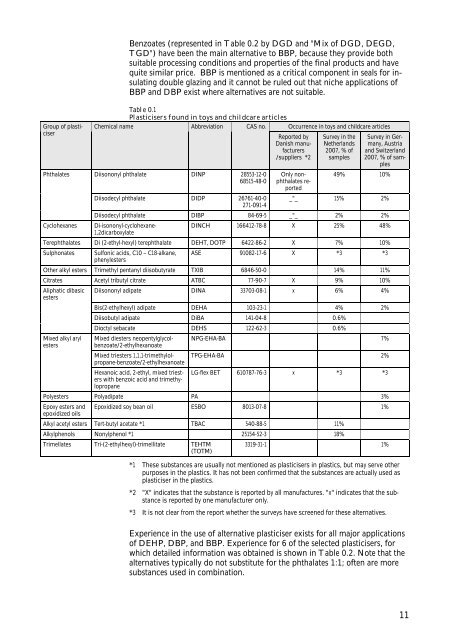Identification and assessment of alternatives to selected phthalates
Identification and assessment of alternatives to selected phthalates
Identification and assessment of alternatives to selected phthalates
Create successful ePaper yourself
Turn your PDF publications into a flip-book with our unique Google optimized e-Paper software.
Benzoates (represented in Table 0.2 by DGD <strong>and</strong> "Mix <strong>of</strong> DGD, DEGD,<br />
TGD") have been the main alternative <strong>to</strong> BBP, because they provide both<br />
suitable processing conditions <strong>and</strong> properties <strong>of</strong> the final products <strong>and</strong> have<br />
quite similar price. BBP is mentioned as a critical component in seals for insulating<br />
double glazing <strong>and</strong> it cannot be ruled out that niche applications <strong>of</strong><br />
BBP <strong>and</strong> DBP exist where <strong>alternatives</strong> are not suitable.<br />
Table 0.1<br />
Plasticisers found in <strong>to</strong>ys <strong>and</strong> childcare articles<br />
Group <strong>of</strong> plasti- Chemical name Abbreviation CAS no. Occurrence in <strong>to</strong>ys <strong>and</strong> childcare articles<br />
ciser<br />
Reported by Survey in the Survey in Ger-<br />
Danish manu- Netherl<strong>and</strong>s many, Austria<br />
facturers 2007, % <strong>of</strong> <strong>and</strong> Switzerl<strong>and</strong><br />
/suppliers *2 samples 2007, % <strong>of</strong> samples<br />
Phthalates Diisononyl phthalate DINP 28553-12-0 Only non- 49% 10%<br />
68515-48-0 <strong>phthalates</strong>reported Diisodecyl phthalate DIDP 26761-40-0<br />
271-091-4<br />
_"_ 15% 2%<br />
Diisodecyl phthalate DIBP 84-69-5 _"_ 2% 2%<br />
Cyclohexanes Di-isononyl-cyclohexane-<br />
1,2dicarboxylate<br />
DINCH 166412-78-8 X 25% 48%<br />
Tere<strong>phthalates</strong> Di (2-ethyl-hexyl) terephthalate DEHT, DOTP 6422-86-2 X 7% 10%<br />
Sulphonates Sulfonic acids, C10 – C18-alkane,<br />
phenylesters<br />
ASE 91082-17-6 X *3 *3<br />
Other alkyl esters Trimethyl pentanyl diisobutyrate TXIB 6846-50-0 14% 11%<br />
Citrates Acetyl tributyl citrate ATBC 77-90-7 X 9% 10%<br />
Aliphatic dibasic<br />
esters<br />
Mixed alkyl aryl<br />
esters<br />
Diisononyl adipate DINA 33703-08-1 x 6% 4%<br />
Bis(2-ethylhexyl) adipate DEHA 103-23-1 4% 2%<br />
Diisobutyl adipate DiBA 141-04-8 0.6%<br />
Dioctyl sebacate DEHS 122-62-3 0.6%<br />
Mixed diesters neopentylglycolbenzoate/2-ethylhexanoate<br />
Mixed triesters 1,1,1-trimethylolpropane-benzoate/2-ethylhexanoate<br />
Hexanoic acid, 2-ethyl, mixed triesters<br />
with benzoic acid <strong>and</strong> trimethylopropane<br />
NPG-EHA-BA 7%<br />
TPG-EHA-BA 2%<br />
LG-flex BET 610787-76-3 x *3 *3<br />
Polyesters Polyadipate PA 3%<br />
Epoxy esters <strong>and</strong><br />
epoxidized oils<br />
Epoxidized soy bean oil ESBO 8013-07-8 1%<br />
Alkyl acetyl esters Tert-butyl acetate *1 TBAC 540-88-5 11%<br />
Alkylphenols Nonylphenol *1 25154-52-3 18%<br />
Trimellates Tri-(2-ethylhexyl)-trimellitate TEHTM<br />
(TOTM)<br />
3319-31-1 1%<br />
*1 These substances are usually not mentioned as plasticisers in plastics, but may serve other<br />
purposes in the plastics. It has not been confirmed that the substances are actually used as<br />
plasticiser in the plastics.<br />
*2 "X" indicates that the substance is reported by all manufactures. "x" indicates that the substance<br />
is reported by one manufacturer only.<br />
*3 It is not clear from the report whether the surveys have screened for these <strong>alternatives</strong>.<br />
Experience in the use <strong>of</strong> alternative plasticiser exists for all major applications<br />
<strong>of</strong> DEHP, DBP, <strong>and</strong> BBP. Experience for 6 <strong>of</strong> the <strong>selected</strong> plasticisers, for<br />
which detailed information was obtained is shown in Table 0.2. Note that the<br />
<strong>alternatives</strong> typically do not substitute for the <strong>phthalates</strong> 1:1; <strong>of</strong>ten are more<br />
substances used in combination.<br />
11

















